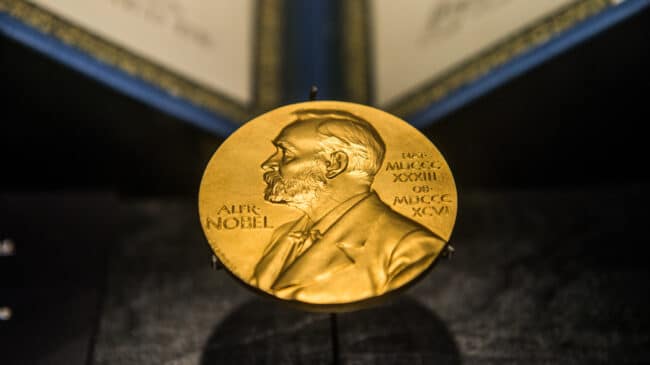The annual Sveriges Riksbank Prize in Economic Sciences in Memory of Alfred Nobel was awarded to Ben S. Bernanke, Douglas W. Diamond, and Philip H. Dybvig on October 10, 2022, for “research on banks and financial crises.” The committee honored Bernanke’s 1983 paper that investigated bank failures through the historical lens of the Great Depression. Diamond and Dybvig were honored for work on the same topic with similar conclusions, but a very different approach–a game-theory model that attempted to explain why bank failures happen, and what they might mean in the broader economy.
Every Nobel announcement is understandably followed by media coverage and acclaim from the recipients’ colleagues, students, and admirers. But this year’s prize has also been met with more immediate and direct criticism than usual. Economists are never shy in expressing their disagreements, but the macroeconomics of banking and financial crises is a particularly stark example.
The debate over this year’s prize is really a continuation of the fiercest and most consequential debate among economists in recent times. The failures of Bear Stearns and Lehman Brothers and the subsequent Great Recession were billed by some as a failure of the economics profession. In the years leading up to the crisis, one leading group of academic macroeconomists did not focus on the banking and financial system in their research, instead solving complicated mathematical models where government policies like taxation and the consumption and saving decisions of individuals determined outcomes in the wider economy. In the wake of the Great Recession they were criticized for deemphasizing the role of banking crises, but they were far from the only leading voices in academia. This year’s prize winners, focusing explicitly on the role of banking in the economy, wrote papers considered highly influential since the 1980s, and Bernanke began leading the Fed just before the crisis erupted.
Economists celebrating this year’s prize generally think that policymakers should have foreseen problems at the big banks in the years leading up to the Great Recession, and did not do enough to soften the blow early on in the crisis. They view the work of this year’s winners as justification for the bank bailouts ultimately put into place. Critics of this year’s prize winners, many of whom opposed those bailouts, are skeptical that the highly technical academic work truly captures the dynamics of banking crises in the real world.
A Model Bank Run
Diamond and Dybvig (often abbreviated “D-D”) won their Nobel prize primarily for their paper “Bank Runs, Deposit Insurance, and Liquidity,” published in the Journal of Political Economy in 1983. The paper attempts to apply rigorous game-theoretic modeling to bank runs and financial crises. The highly stylized model features two types of economic agents: savers who demand liquidity and borrowers who take out long-maturity loans to invest. D-D show that equilibrium is possible that looks, in broad strokes, like a bank run. Too many savers demand their deposits back and create a situation where the financial institution at the center cannot satisfy all withdrawals. The work has been used as justification for government intervention such as deposit insurance.
Praise for D-D often focuses on how influential the work has been in academia and policy circles. Zhiguo He and Yueran Ma, colleagues of Diamond at the University of Chicago’s Booth School of Business, call his work “the perfect balance between practical relevance and academic rigor.” Ricardo Reis of the London School of Economics says, “the lesson that a lender of last resort and fiscal backstops are needed to prevent runs has been internalized across the board.” Cato Institute Senior Fellow George Selgin, a critic of the D-D model, notes that at “well over 12,000 Google citations and counting, it’s certainly among the most cited academic papers in economics, let alone in the sub-discipline of monetary economics.”
Critics like Selgin and Larry White of George Mason University see very limited value in what we can learn from a stylized game-theoretic model of bank runs and similar financial crises, where history and institutional details can teach us more than equations. In his 1999 book The Theory of Monetary Institutions, White notes that the D-D model fails to capture the essential features of the basic deposits and loans that fuel most banks. In a 2020 two-part article on the site Alt-M, Selgin offers several critiques of D-D, including that the various types of equilibria they find depend on knife-edge assumptions. One of these issues is a “sequential service constraint,” where D-D require their modeled bank to satisfy the requests of depositors to get their money back on a first-come, first-served basis but exempted a public deposit insurer from this rule.
Commercial banks, not to mention highly complex modern financial institutions like the ones that failed in the Great Recession, have an uncountable number of institutional details poised to dramatically alter the results of any game-theoretic model. Selgin underscores the need for monetary economists to take history and institutional details seriously by quoting Sir John Hicks:
“Monetary theory is less abstract than most economic theory; it cannot avoid a relation to reality, which in other economic theory is sometimes missing. It belongs to monetary history in a way that economic theory does not always belong to economic history.”
Bernanke and Bailouts
The name Ben Bernanke will surely be the most familiar to readers of this year’s three recipients. As Federal Reserve Chairman during the great recession, Bernanke played among the leading roles in engineering the bailouts of Lehman Brothers and other financial institutions. Bernanke’s prize, unlike the prize awarded to Diamond and Dybvig, is for a work of economic history. More accurately, it is for one notorious episode of economic history.
Also published in 1983, “Non-Monetary Effects of the Financial Crisis in the Propagation of the Great Depression” argued that bank runs had a causal impact on worsening the Great Depression, as “the resulting higher cost and reduced availability of credit acted to depress aggregate demand.” Therefore, propping up specific institutions could help mitigate future crises’ effects. Sound familiar?
Bernanke begins by characterizing his result as “complementary to that of Friedman and Schwartz, who emphasized the monetary impact of the bank failures.” Friedman and Schwartz famously and influentially argued that the Federal Reserve failed to act as a lender of last resort, precipitating a dangerous drop in the money supply. Bernanke does not explicitly argue against that conclusion, framing his work as “focusing on non-monetary (primarily credit-related) aspects of the financial sector.”
In praise of Bernanke and his prize, Paul Krugman argues that the work was “a tacit rejection of Milton Friedman.” Krugman considers this a good thing—Bernanke’s view of bank failures as a specific cause of the crisis “was dramatically validated in the 2008 financial crisis.” Moreover, Krugman writes that Bernanke “understood what was going on, and the Fed stepped in on an immense scale to prop up the financial system.”
Writing in the Wall Street Journal after this year’s prizes, Hoover Institution research fellow David Henderson also sees Bernanke’s work as not being in harmony with the seminal contribution of Friedman and Schwartz. But, unlike Krugman, Henderson does not view this as praiseworthy:
“The difference between the Bernanke and Friedman/Schwartz views was that Mr. Bernanke thought providing more liquidity during a crisis wasn’t enough; he emphasized the importance of salvaging particular financial intermediaries, even if some of them arguably should have gone bankrupt. While his academic work on this issue was deep and impressive, it, unfortunately, caused him, as Fed chairman, not to focus on liquidity during the financial crisis.”
The 2022 Nobel Committee unequivocally endorsed both the value of activist central banking and the view that our standard economic toolkit can reveal clear and generalizable interventions when banking crises loom. Many Reason Foundation readers may find themselves opposed to this view and may look to the critiques levied by White, Selgin, and Henderson to offer much insight. These critics of the 2022 prize winners do not see the problem as bad economics, but rather as the limitations of even good economics when one must make policy in the real world.
Henderson notes the depth and impressiveness of Bernanke’s academic work but posits that it caused him to focus on one aspect of the 2008 crisis at the expense of others. Selgin echoes these sentiments when he writes that “my beef isn’t with Diamond and Dybvig per se. It’s with those who assume that their model supplies adequate grounds for government intervention in banking.”
The formal models and highly focused work of academics can inform banking policy, but too often such work instead creates the sort of tunnel vision that could lead even Nobel-caliber economists to questionable conclusions.

